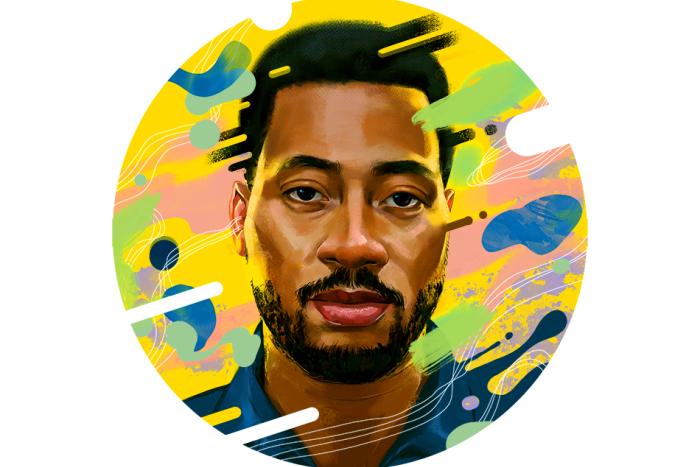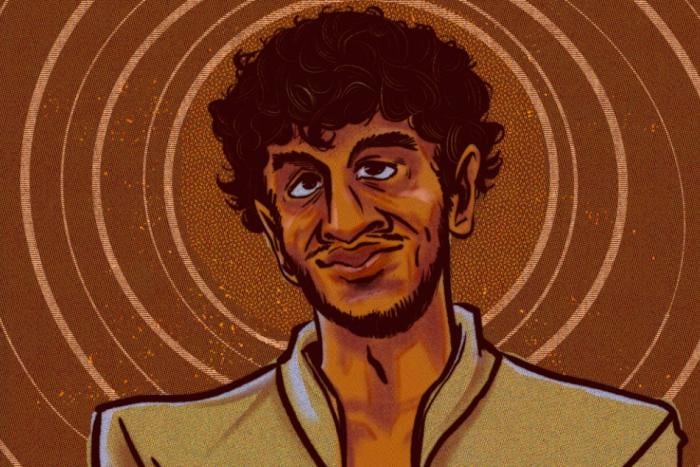How does a character in a Stephanie LaCava novel mourn? When I called her to discuss the release of her second novel, I Fear My Pain Interests You (Verso Books), it was a weekend morning for me and the afternoon for her: just a few days since coming from an event in Paris, she was spending some time in London. Jean-Luc Godard had passed away only four days earlier, and on that Saturday a line was snaking all the way around the city for British citizens to view their deceased queen. If the internet can be said to have an atmosphere, then the impulse to pay homage to a great filmmaker was strong in the air; a resistance to an overly nostalgic or conciliatory narrative that tried to erase the monarchy’s endless oppressions, even more so. In between both was that great dissociative distance that comes from viewing life through a pixelated screen. I pictured one of LaCava’s heroines clicking through tweets the way someone stuck in traffic might change the radio station: having given up on relief, she might still find distraction.
I Fear My Pain Interests You is the story of Margot Highsmith, a daughter born to two parents with two very different kinds of fame. She has inherited her mother’s generational glamour, and her father’s punk credentials. With this comes a perpetual grief that she is not quite sure how to bear: she never chose to be looked at so intently, the subject of paparazzi photos and scrutiny by obsessive fans, but now that she has the attention, she is also not so sure she would choose to give it up. Half-heartedly courting an acting career while navigating the micromanagement of her grandmother’s guardianship, Margot is dimly aware that she is missing something other people have, besides anonymity. She has a condition called congenital analgesia, meaning she cannot experience physical pain.
This is, as the title suggests, a worrying way to receive someone’s intrigue. As the novel progresses, her affair with an older, more powerful director throws her into a different kind of feeling; her chance encounter with a man in a graveyard (only referred to as “Graves”) begins, after he discovers her diagnosis, to hint at what might be some ulterior motives. Depressed, isolated, and deprived of her own creative outlet, Margot’s plight is tragic, but not without its own perverse sense of comedy: no pain, no fame.
LaCava’s first novel was The Superrationals, about missed connections and distant lovers amongst academics and art world workers. A critic, essayist, memoirist, and the founder of an independent publishing house called Small Press, she is intimately familiar with the way lives can contract or expand around the facts of a biography. In both works, LaCava begins her stories in the small circles that congregate around even smaller creative scenes, pulling loose the tight beliefs characters have about their power and what they might deserve, their reaction to or possession of beauty, and the limits of reaching out to people just like them. They cherish style, reject taste, and revere icons. In the interview below, which has been condensed and edited for clarity, LaCava and I spoke about her process, her artistic associations, and what comes after the end of writing a book.
Haley Mlotek: Sometimes it seems that certain themes all rise to the surface at the same time. As I read I Fear My Pain Interests You I was thinking of Crimes of the Future, and how people find themselves linked around a similar idea. When you began working on this novel, were you actively noticing some of those references, or was it more like you found them as you went along?
Stephanie LaCava: The book was just what was going on with me at that moment, in my own vortex. It had nothing to do with anything else, but I find it magical and fascinating when it does happen in the culture. My friend got me that shirt from the film— “Surgery Is The New Sex”—it was so crazy that that happened.
But then, there are ideas right under the surface, and a lot of them are political themes coming up at the time. They’re macro themes that are broken down into visual art, music, anything like that, and it just sort of happens because what’s in the air is often what’s happening in our world all over.
There are certainly what could be called fashions of literature, where the political climate or cultural obsessions that writers are exploring are easily grouped together.
I’ll have to say that that question has attacked me from all angles in ways I didn’t expect. People have tried to ask, like, Are you part of the disassociated feminism thing? And the answer is definitely not, and I explained why. Then they would ask, Are you part of the sad little pretty girl thing? And I would say definitely not, and here’s why. Is it similar to My Year of Rest and Relaxation? Definitely not, and I explained why. It made me realize something about my own writing. Through these questions, I was suddenly able to form my own kind of theory. My book is almost post-all of those, in a sense. It’s definitely not a #MeToo story, it’s not a trauma story—it’s actually the opposite of a trauma story. I mean, again, not on purpose; I wasn’t aware of it as I was writing, but it happens to be the opposite. It’s a story of a woman who is aware of her complicity and aware of the politics underneath wanting to be something better, but she lives in the world that exists as it is. The idea of feeling pain or no pain changes the whole realm of that kind of theoretical discussion. I don’t think I Fear My Pain Interests You fits in with any of them. I think it’s the next thing.
How would you define a timeline of those pre- and post-genres that you’re describing? Sometimes I feel like everything is so over-categorized; everything is just made to be contained, whether it fits in or not. But it is true that often one thought or theory follows another. How did you lead yourself to a place you describe, of writing into an era that comes after now?
What’s going on with Margot—the voice of the book—is what’s different. Parts of the book are more about spacing, about absence . . . I’m not a literary history expert so I’m not so qualified to say much about what these genres mean, or to enter into a discussion with those kinds of books . . .
There’s something about literature and novels that can feel so daunting! They come with this strange weight.
And in English! I’m so interested in works in translation. I sometimes think that my work reads as in translation, even though it’s written in English, if that makes sense. The cadence has more of a French approach to punctuation; and we accept different things as readers when the characters are different, when the symbols are different, for example. I think about all of that, and then I think about what’s not on the page. That’s harder to discuss, but it’s something intuitive, maybe?
It could be like reading screenplays, in the idea of the spacing on the page. I’ve been reading a lot of Louise Glück recently, which I hadn’t before. I read this book about a garden throughout the summer. I decided to read essays about writing poetry because I felt like I could learn something about my writing through that. I don’t want poetry, but I’m interested in studies of it—not because I want to try writing poems, but because of the way I want to write prose.
I’ve always thought poets write the best prose.
Yes. And wanting to learn the language of critiquing poetry . . . I just want to learn the language of other things, like, I don’t know, mountain biking.
Maybe that’s a good way to start talking about your process, and how you find and build your ideas. You’ve spoken before about finding a clipping about congenital analgesia, and how that ended up becoming a fact of Margot’s character in I Fear. How do those early sketches become a story?
I found that clipping and I knew I wanted to write a story about it. I wasn’t heavily researching the systems; it was more about the idea of the absence of pain than the actual neurochemistry, although I was interested in the neurochemistry too. I had also always been interested in this idea about love being based on oxytocin, which comes when one orgasms, and what that means for bonding and the realities of falling in love—what is lust, what is real, what is chemical. The specifics of what I wrote were more about wanting it to act as an absurdist, surrealist device.
I started there and wanted to see where it would take me. Interestingly, it started with the cows, too. I guess I have a little penchant for cows, too. There’s the Peter Hujar portraits in the inside cover, and obviously the epigraph is “Cows are not sentient beings.” There’s an idea that cows are these creatures that are raised knowing, in many ways, that they are there to suffer. The sadism of the condition comes up throughout the book, what it means to be a creature that’s inevitably doomed but also revered. We’re all so many things, and symbols can mean so many things.
I would take notes in these notebooks that my son does watercolours on. I would fill each notebook up, sometimes writing the same thing over and over again, or sometimes I would just sit with it. It’s almost like I keep writing until it becomes this thing, and then the writing process happens super fast. This book was ten years in the making, but it wasn’t ten years being written at my computer.
Yes, because so much of writing is that thinking and processing. You’ve also mentioned this concept of absence or space in your finished work. Was there ever a time when you stepped away from this idea for a period, and then had to get yourself back into it? Did time change the writing?
To be honest, I probably should do that more. That would be something everyone in my life would tell me to do. But I’m a bit compulsive, and obsessive, so that’s hard for me. I think I just wrote through the absence, if that makes any sense, which is kind of apropos: I wrote the absence. That paradox is just what it is. I kept writing until it was no longer an absence, or it was a deeper absence.
A purposeful absence. And you mentioned screenplays—was there any work you did to understand your characters that might not appear on these pages, in the same way we often have to understand a film character by the way they behave rather than what they say?
My work is very cinematic, in terms of setting the scene. And I feel like the way I write on the page looks like a screenplay. So much of the book is about what’s left out and withheld, and that’s so much of who Margot is . . . so I can’t tell you.
Oh, so it must stay a secret. Well, there is a rich tradition of a woman at the center of a story who will drive you crazy because you can’t tell what she’s thinking. As I was reading I Fear My Pain, I was alternating between the eulogies for Jean-Luc Godard, and thinking about the different ways different audiences romanticize and project onto his images, and the kind of Tumblr user who would have come to Godard through stills of Jean Seberg.
For me that goes back to the dissociative feminism thing, the aestheticizing of a certain sort of teen. Everything really does come in cycles, and I am very interested in the ways they become aestheticized. This book is very much that—it fits into these waves of taxonomies. People have said to me before that my work is a bit like being a visual artist on the page; not that literally, but that also doubles over into the idea of Margot being a beautiful cipher as a window into exploring other things.
So if there are common aesthetics to your work, let’s say, “beautiful cipher” might be a good phrase to start with. Do you have a theory of or a conscious language for how you would describe what connects your work?
For me, it’s very intuitive. I’ve never really tried to give it words, which is funny, because I create in words. But I’ve always left the theorizing to someone else. Can I ask you what you would say it is?
Well, I did like beautiful cipher. That’s a good phrase. And I was thinking when I was reading I Fear My Pain Interests You and The Superrationals that there’s a funny fluidity of movement in both your novels—it’s very easy for your characters to get from one place to another, but once they arrive, they’re a little bit stuck. A combination of being in flight and total inertia.
The fight-or-flight impulse is very present in my work, and so is dance, and both kind of converge in what you’re saying. A big thing for me, too, is this idea of being passive. Throughout the book there are examples of people who are passive, but full of words to say, and then people who are active, but silent. I think that’s a simple way of me trying to deal with a constant in my life, which is having trouble when people’s words don’t match their actions or when there’s a dissonance between them. There’s this idea that you can almost have justice by logging someone’s words; it’s a very childlike way of looking at the world. And also, how passivity can seem cool, but in the end, passivity is one of the weaker, trashier things one can do in terms of how to live a life. It’s especially a kind of privilege to believe that you can just never move. In the book, no one shows any care for Margot except for Lucy, and Lucy’s care is action.
There’s a marked difference in Lucy and every other character that makes it clear she’s a true friend. And speaking of that character and theories of your work, I understand what you mean about how it’s not necessarily for you to say, because sometimes we’re too close to what we do to really see it, and that’s what a reader or a critic is for. I did, at the same time, notice there was some self-referential material in this book . . .
Self-deprecating. The opposite.
[Laughs] But Lucy’s mother does give Margot a copy of your book, The Superrationals.
Yes.
So, when you thought of Margot as a character, were you thinking of her as somebody you could encounter who could read your novels in her world?
I’m just thinking of it as taking the piss out of myself, basically. There’s a lot of stuff like that throughout the book that people have been noticing—someone called it Easter eggs, which I liked—but I’m not thinking beyond just making jokes about the fact that I’m not self-serious.
Right, you leave those little jokes for yourself and for your reader. Do you think of yourself as the kind of writer who writes towards a specific person, either in life or towards a reader?
Definitely not. But what I am doing, and this is very honest, is often I’m dealing with emotional pain, and the only way I can get through it is by doing the story. It’s not directed towards anyone. It’s more of an exorcism for me. For me, it was like: I got to survive, and I got to process this thing that happened, I’m going to write this book.
But it’s not like you get it all down and it goes away. I mean, that would be a very shallow place for it to have started. When you’re continually asked smart questions, it makes you look to where it began, a resurgence of certain things. I’m just really, really trying not to get too dark and to start working on the next thing. I feel grateful that I get to do these things so that I can have a job writing, and now I just want to write the next book.






